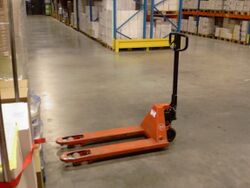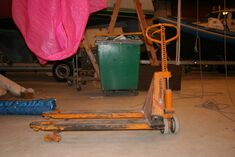Finance:Pallet jack

A pallet jack, also known as a pallet truck, pallet pump, pump truck, scooter, dog, or jigger is a tool used to lift and move pallets. Pallet jacks are the most basic form of a forklift[1] and are intended to move pallets within a warehouse.
Operational principle
The jack is steered by a tiller-like lever called a 'tow bar' that also acts on the pump piston for raising the forks. A small lever on the tow bar's steering handle releases the hydraulic fluid, causing the forks to lower. The steering wheels are located directly below the tow bar and support the jacking mechanism.[2] The front wheels inside the end of the forks are mounted on push rods attached to linkages that go to levers attached to the jack cylinder. As the hydraulic jack at the 'tiller' end is raised, the links force the wheels down, raising the forks vertically above the front wheels, raising the load upward until it clears the floor. The pallet is only lifted enough to clear the floor for subsequent travel. Oftentimes, pallet jacks are used to move and organize pallets inside a trailer, especially when there is no forklift truck access or availability.
-
Pallet jack in lowered position, allowing it to be inserted under a load on a pallet
-
Jack showing how wheels drop, lifting forks and load. The steering tiller and raised hydraulic cylinder are clearly visible on the right
-
Underside of a jack showing linkages under forks
History
Manual pallet jacks have existed since at least 1918.[3] Early types lifted the forks and load only by mechanical linkages. More modern type uses a hand pumped hydraulic jack to lift.
Types
Manual pallet jack
A manual pallet jack is a hand-powered jack most commonly seen in retail and personal warehousing operations. They are used predominantly for lifting, lowering and steering pallets from one place to another.
Powered pallet jack

Powered pallet jacks, also known as electric pallet trucks, walkies, single or double pallet jacks, or power jack, are motorized to allow lifting and moving of heavier and stacked pallets. Some contain a platform for the user to stand while moving pallets. The powered pallet jack is generally moved by a throttle on the handle to move forward or in reverse and steered by swinging the handle in the intended direction. Some contain a type of dead man's switch rather than a brake to stop the machine should the user need to stop quickly or leave the machine while it is in use. Others use a system known as "plugging" wherein the driver turns the throttle from forward to reverse (or vice versa) to slow and stop the machine, as the dead man's switch is used in emergencies only.
Rough terrain pallet jack
Rough terrain pallet jacks are designed specifically for use on uneven ground. They are made using heavy-duty frames and robust pneumatic tyres so that they can be manoeuvred over rough surfaces with ease. Many manufacturers opt for watertight wheel bearings, a hydraulic elevator or a built-in pump to ensure their rough terrain pallet jacks are easy and comfortable to use, even in the harshest conditions.
Operational limitations
- Reversible pallets cannot be used.
- Double-faced non-reversible pallets cannot have deck-boards where the front wheels extend to the floor.
- Enables only two-way entry into a four-way notched-stringer pallet, because the forks cannot be inserted into the notches.
- Power jacks have difficulty in confined spaces (coolers) and narrow openings.
Operational risks
Pallet jacks are classed as material-handling equipment (MHE). Under most health and safety law, training is required in their use (particularly for powered pallet jacks) and, as the loads carried are heavy, there is a substantial risk of accidents resulting in injuries.[4]
Typical dimensions
Industry seems to have 'standardized' pallet jacks in several ways:[according to whom?]
- Width of each of two forks: 180 mm (7 in)
- Fork width, i.e. The dimension between the outer edges of the forks: Available as 510 and 690 mm (20 1⁄4 and 27 in)[5]
- Fork length: Available as 910, 1,070 and 1,220 mm (36, 42 and 48 in)[5]
- Lowered height: 74 mm (2.9 in)[5]
- Raised height: At least 190 mm (7.5 in),[5] but some will raise higher
In Eurasia the overall dimensions are similar, as modern container palletization has forced standardization in the dimensional domain globally.
See also
- Unit load
- EUR-pallet
- Manual handling of loads
References
- ↑ The Forklift Manual Ryan, John (2006). The Forklift Manual. Donegal Bay Inc. Publishing. p. 7. ISBN 9780977799732. https://books.google.com/books?id=EIjbH3uImsMC.
- ↑ "What is a pallet jack?". https://www.sourcefy.com/articles/whats-a-pallet-jack/.
- ↑ "This New Truck Gets Under The Load And Lifts It" (Scan by Google Books). Popular Science Monthly (Modern Publishing Company (Bonnier Corporation)) 93 (6): 54. December 1918. ISSN 0161-7370. https://books.google.com/books?id=EikDAAAAMBAJ&pg=PA54. Retrieved 31 August 2014.
- ↑ "Types of Pallet Jack Accidents, With Examples". https://www.drivingtests.co.nz/resources/types-of-pallet-jack-accidents/.
- ↑ 5.0 5.1 5.2 5.3 "Standard 2.9" Pallet Jack". U.S. Global Resources (USGR). http://www.usgr.com/pallet-jacks/standard_29_pallet_jacks.php.
External links
 |



